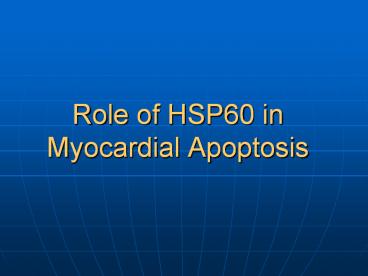Role of HSP60 in Myocardial Apoptosis - PowerPoint PPT Presentation
1 / 30
Title: Role of HSP60 in Myocardial Apoptosis
1
Role of HSP60 in Myocardial Apoptosis
2
Heat Shock Proteins
- Highly conserved proteins in all pro- and
eukaryotic cells - Expressed as intracellular response to stress
which includes ischemia, hypoxia, ATP depletion
and free radicals - Accumulation of heat shock proteins in cardiac
cells enhances myocardial resistance to
ischemia/reperfusion injury and improves
post-ischemic recovery of cardiac function
3
Heat Shock Protein 60
- HSP60 is constitutively expressed in the
cytoplasm and is translocated to mitochondria - HSP60 promotes folding of many proteins imported
into the mitochondrial matrix and maintain normal
mitochondrial function - HSP60 plays a role in protecting cells against
injury and has a role in cardioprotection - About 65-75 of HSP60 is mitochondrial, whereas
25-35 is extramitochondrial
4
Hsp60
5
Role of HSP60 as intracellular molecules
6
Decreased expression of HSP60 induces apoptosis
Levels of HSP60 after antisense treatment
7
Cardiomyocytes viability after AS treatment
8
Cytochrome c release and caspase-3 activation
after antisense treatment
9
Levels of bax, bak and Bcl-2 after AS treatment
10
HSP60 , Hypoxia and Apoptosis
- Adult rat myocytes were studied at end-hypoxia
and at 10 and 24h of reoxygenation - HSP60 levels were unchanged at end hypoxia and
decreased 33 and 40 at 10 and 24h of
reoxygenation - Mitochondrial HSP60 was unchanged while cytosolic
HSP60 translocates to the plasma membrane - In cytosol in the absence of HSP60, bax moves to
the mitochondria and causes cytochrome c release
and apoptosis
11
HSP60 levels during hypoxia/reoxygenation
12
Cyt c release during hyp/reox
13
Bax levels during hyp/reox
14
Bcl-2 levels during hyp/reox
15
HSP 60 and bax localization in cytosol and
org/memb after hypoxia
16
Distribution of HSP60 and bax in plasma membrane
and mitochondria after hypoxia
17
Co-localization of Bax With HSP60
18
PLASMA MEMBRANE
HSP60
BAX
STRESS
CYTC
CYTC
HSP60
HSP60
MITOCHONDRION
CYTOPLASM
19
Extracellular HSP60
20
HSP60 as an inducer of Inflammation
21
(No Transcript)
22
Binding of HSP60 to cardiomyocytes
23
Role of HSP60 in Plasma Membrane
24
Release of Cytokines by HSP60
25
Identification of post-translational
modifications of HSP60
26
Glycosylation of extracellular HSP60
27
Extracellular HSP60 and Apoptosis
28
(No Transcript)
29
Conclusions
- Endogenous HSP60 acts as a protector of the cell
by stabilizing macromolecules - Intracellular HSP60 is antiapoptotic as it binds
with proapoptotic bax - Extracellular HSP60 induces apoptosis
30
Future Directions
- What is the regulation and function of movement
of HSP60 to the plasma membrane? - Is HSP60 a ligand for TLR4 on the membrane?
- Is membrane HSP60 released?
- Do post-translational modifications alter the
toxicity of exogenous HSP60?































